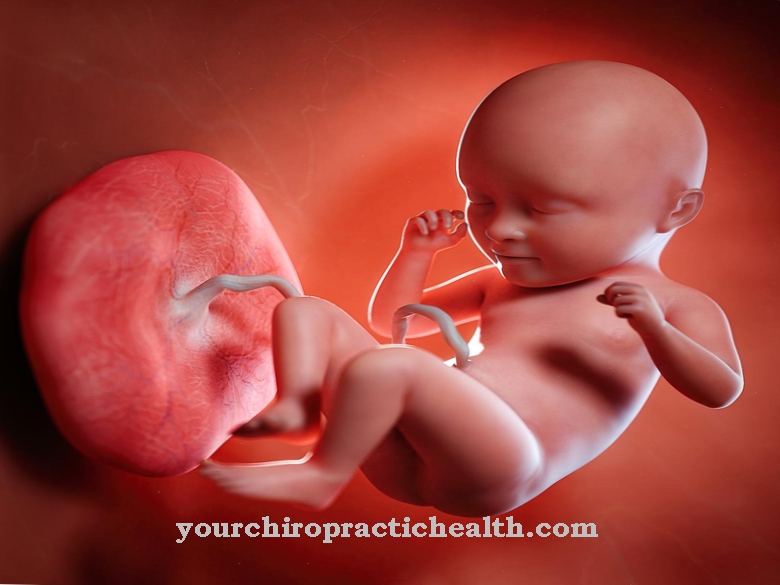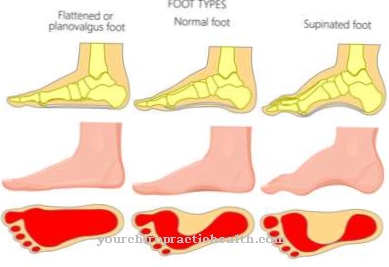The names Red Green weakness, Red-green poor eyesight or Red-green blindness are the technical terms for the most common color ametropia, colloquially known as color blindness. Contrary to popular belief, the red-green-blind are not necessarily unable to recognize these two colors; there may also be a lack of distinction.
What is a red-green weakness?

© euthymia - stock.adobe.com
The Red Green weakness is a retinal defect that affects about eight to nine percent of the male and only about one percent of the female population. There is a defect in one, two or all of the receptors in the eye responsible for conveying color, which leads to general color blindness or the most common color visual impairment, red-green blindness.
The red-green visual impairment, which is also called Daltonism after its discoverer John Dalton. Those affected suffer from limited color vision. They are not able to differentiate between the colors red and green, and problems can also arise when differentiating between various other colors if green or red has been added to them.
The disease can occur in different forms and is usually not experienced by those affected as being a hindrance. In particular, when choosing a career, a present red-green visual impairment is an obstacle; those affected are not allowed to practice some professions such as seaman, police officer, taxi driver or pilot.
The red-green visual impairment can, however, also be an advantage for those affected, who react more sensitively to levels of brightness, which means that they have a fundamentally better night vision, and can differentiate between khaki tones and shapes and contours better than those who are not color-defective. The military likes to work with color blind people to check the effectiveness of camouflage suits.
causes
The cause of the Red-green blindness is a genetic change in the cones of the retina. Errors in the transfer of genetic information to the chromosomes result in incorrect gene combinations, which lead to cone function disorders.
The exact processes that lead to a red-green weakness are very complicated and can be looked up in the relevant medical dictionaries. It is important to know that a red-green weakness is always innate and it is inherited recessively.
Scientists suspect, in addition to the disturbance of the cone function, a reduced number of cones on the retina with an increased number of rods. The rods of the retina are responsible for seeing through light and dark, which would explain the increased ability to see at night compared to people with normal vision. So far, however, this thesis has not been proven.
Symptoms, ailments & signs
The main symptom in the presence of red-green weakness is the reduced ability to see the corresponding colors. This affects the ability to differentiate between the colors red and green. However, there are numerous gradations here. A red-green weakness does not necessarily mean color blindness.
Rather, it can also lead to a poorer distinction between red and green. This can be done depending on the exact color. It may be that certain nuances of red and green are indistinguishable for the person concerned, while other nuances are clearly different for him. As a result of the limitation in seeing red and green, those affected have the result that they perceive significantly fewer different shades of color.
The more the perceived wavy lines overlap in the corresponding cones of the eyes, the more difficult it is for those affected to distinguish between red and green. Most of those affected refer to the colors as shades of gray or brown. In either case, both eyes are affected and the disease lasts for a lifetime.
Since most of those affected have not even experienced correct color vision, there are hardly any restrictions. The other eyesight is not restricted. Those affected by red-green weakness can also compensate for their limited color vision. This is achieved by classifying the perceived brown or gray tones or by simply knowing what color an object should be.
Diagnosis & course
The self-test on Red-green poor eyesight has been possible without any problems since the introduction of the euro in the European Union, as physicists at the Universidad de Extremadura in Cáceres found: Anyone who cannot distinguish the color of the 5 and 20 cent coins is almost certainly red-green-blind.
Since those affected cannot distinguish between shades of color in which there is a high proportion of red or green, it is not possible for them to objectively differentiate between these two coins.
Of course, ophthalmologists have more extensive diagnostic methods at their disposal to diagnose not only the red-green weakness, but also its severity. The Ishihara color tables, the Farnsworth test and the spectral color mixer are used most frequently. The task on the spectral color mixer is to set a yellow circle based on color mixtures, with color defective vision quickly becoming apparent.
This complex test is the typical professional aptitude test. It is easier to test for the ability to differentiate colors with the Ishihara color tables, on which numbers are shown in blobs of colored paint, and with the help of the Farnsworth test, which assigns the test person the task of assigning colors.
Complications
There are no real complications in the medical sense when there is a red-green weakness. It is an actual condition in the eye, which does not mean any organic impairment and also does not mean any increased risk for any diseases in the eye area.
Complications in the broadest sense only arise for those affected if their color vision impairment specifically limits them. This can be the case, for example, when choosing a career, where correct color vision is necessary, for example as a pilot or in the course of laboratory tests. Whether this affects those affected significantly is an individual question.
Most of those affected, however, can come to terms with their red-green weakness very well - if only because they don't know any other way. When driving at night, however, a red-green weakness can mean an increased risk of accidents. After all, red-green traffic lights are very difficult to perceive in poor light for people with red-green poor eyesight.
Furthermore, very specific problems occasionally arise in everyday life. For example, the colors red and green are often used to differentiate or mark elements (text, images, toys, etc.), signs and numerous everyday items as well.
When should you go to the doctor?
People who notice impaired vision should always consult a doctor. The extent of the visual disturbance and the cause of the complaints must be clarified. A diagnosis is required so that a suitable treatment plan can be worked out. Fuzzy vision, problems recognizing moving objects or abnormalities in color perception should be discussed with a doctor.
If visual discrepancies can be determined in direct comparison with people in the immediate vicinity, the person concerned needs various tests to clarify the symptoms. A direct exchange with other people in everyday life helps to assess the existing problem. It should be used as a basis for describing irregularities noticed by the doctor as precisely as possible.
If adults notice abnormal behavior or special features in color descriptions of objects in their offspring, they should consult a pediatrician with them. Naturally, the children cannot be active independently and must therefore be presented to a doctor. Since the red-green weakness can lead to considerable problems, especially in road traffic, the person affected is subject to an increased risk of accidents. If there are developments that corroborate the suspicion of a color perception disorder, a doctor should be consulted as soon as possible.
Many sufferers do not notice the disorder for a long time. As soon as there are indications and suspicions, a medical consultation is advisable.
Treatment & Therapy
Since those affected the Red-green poor eyesight are able to cope with their life very well and rarely experience themselves restricted in the exercise of their everyday lives, therapy is usually not necessary. Therefore, no treatment options that can be used in humans have been developed to date.
Another reason for the lack of therapy options is the interest of science in color-blind people, as they can be used to test theories about the development of human eyesight.
In 2009 British researchers succeeded in using gene therapy to induce the ability of red-green-blind squirrel monkeys to recognize the entire color spectrum. The research team expects these results to provide therapeutic approaches to cure color vision deficiencies and possibly even blindness.
You can find your medication here
➔ Medicines for visual disturbances and eye complaintsprevention
A prevention of red-green weakness is currently not known, as it is a congenital disorder. On the other hand, the red-green weakness is also not considered a disease or symptom that can severely hinder a normal and healthy life. From this point of view, there is no need to prevent red-green weakness.
Aftercare
A red-green weakness cannot be cured and cannot be prevented. It influences the patient in various aspects of everyday life throughout their life. For this reason, consistent care by an ophthalmologist is necessary in order to be able to integrate the poor eyesight more easily into everyday life.
An improvement or healing of the symptoms is the exception with a red-green weakness. This is especially true if the poor eyesight is congenital. Surgery is also not possible. However, if a specialist discovers a red-green weakness early on, it can be treated satisfactorily. This is primarily the case with a non-congenital red-green weakness.
Follow-up care should improve the quality of life of the person affected. This affects not only the ability to see, but also the mental state. If the patient perceives his red-green weakness as very stressful or restrictive and suffers from it, parallel psychological care is advisable in addition to the ophthalmological check-up. In this way, depression is prevented.
During follow-up care, particular attention is paid to mobility, as red-green weakness can significantly limit the patient's participation in traffic. Driving is sometimes impossible. In order to better cope with these and comparable restrictions, appropriate exercises are necessary, which the ophthalmologist carries out with the red-green-blind person.
You can do that yourself
People with a red-green weakness can use special lenses that expand or filter the color spectrum. Since these lenses change the perception of colors, they may not be used while driving a car or working on certain machines. Some color correction glasses are individually adapted to the degree of ametropia, which means that the red-green weakness can be almost completely corrected.
People who suffer from total color blindness may need dark sunglasses. These special glasses have special edge filters that filter certain colors and enhance others. This enables those affected to read small letters and see colors that were previously invisible due to the red-green weakness.
Patients who suffer from red-green weakness usually need support in everyday life. The help of friends or acquaintances makes sense, especially in traffic and with fine work. In addition, the sick should consult their ophthalmologist regularly. The special glasses mentioned are just one of many current developments that could enable almost normal color perception in the future. Depending on the degree of color ametropia, the choice of profession must be reconsidered. Sick people usually cannot become a pilot or train driver.

























.jpg)


